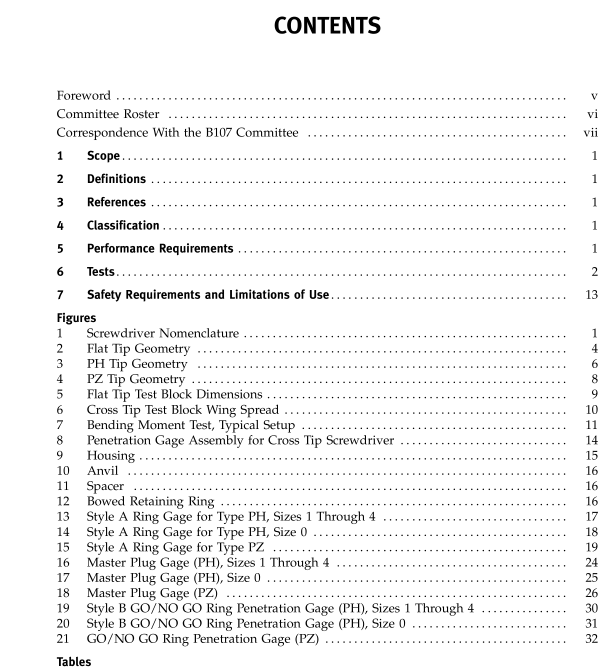ASME B107.600:2016 pdf free download Screwdrivers and Screwdriver Bits
Class 1 flat tips are for driving and removing slotted screws and shall conform to the dimensional and performance characteristics specified in Table 1 and Fig. 2. Taper at the tip shall be centered within 5 deg of the shank axis.
Class 2 (PH) tips are for driving or removing screws with Phillips recesses and shall conform to the dimensional and performance characteristics specified in Table 2 and Fig. 3. Tip dimensions shall be gaged in accordance with paras. 6.8 and 6.9.
Class 3 (PZ) tips are for driving or removing screws with Pozidriv recesses and shall conform to the dimensional and performance characteristics specified in Tables 3 and 4 and Fig. 4. Tip dimensions shall be gaged in accordance with paras. 6.8 and 6.9.
5.2 Materials The materials used inthe manufacture ofscrewdrivers and bits shall be suchas to produce products conforming to the requirements of this Standard.
5.3 Markings Screwdrivers and bits shall be marked in a plain and permanent manner with the manufacturer’s name or with a trademark of such known character that the man- ufacturer shall be readily determined. Marking shall be as permanent as the normal life expectancy ofthe screw- driver to which it is applied (providing the marked surface has not been subjected to a fretting or abrading action) and be capable of withstanding the cleaning pro- cedures normally experienced during its intended use.
5.4 Finish Metallic components of screwdrivers and bits shall be essentially free from scale, seams, laps, cracks, or any condition thatmay adversely affectdurability or service- ability of the tool. Screwdrivers and bits shall be treated in a manner to resist rust or corrosion. There shall be no evidence of peeling or chipping of any coating, where applicable.
5.5 Handle
The handle shall be suitably finished to provide acomfortable grip. The handle shall be free from roughedges,sharp corners, or tool marks that affect comfortwhile using the tool.
When the handle is furnished with a cushion grip,there shall be no detectable slippage between the handleand cushion grip under normal usage.
5.6 Hardness
Type I screwdrivers’ tip portion or the entire bladeshall be hardened to not less than 50 HRC. Type II bittips (for a minimum distance of tor L) shall be hardenedto not less than 56 HRC. The rest of the bit shall behardened to not less than 50 HRC.
6TESTS
wARNING: Many tests required herein are inherently hazard-ous,and adequate safeguards for personnel and property shallbe employed in conducting such tests.These tests are designedto evaluate the tools and materials and do not condone the useof the tools in an environment, or in a manner, inconsistent withsafe use of the tools.
6.1 Hardness Test
The Rockwell hardness test shall be conducted inaccordance with ASTM E18.
6.2 Tip Torsional Test
The tip of each sample under test shall be fixtured ina test block of applicable dimensions shown in Table 1and Fig. 5 (Class 1),Table 2 and Fig. 6 (Class 2),orTable 4 and Fig. 6(Class 3). The test block shall have ahardness of not less than 60 HRC.
When tested to the minimum tip torque value speci-fied,neither the shank nor the tip shall show visiblepermanent deformation. The torque shall be applied byforces acting perpendicular to the long axis of the blade/bit with the tip held securely in the test block. It ispermissible to support the blade / bit in a suitable posi-tion for test.The blade / bit shall be restricted fromendwise movement during testing.
6.3 Assembly Torsional Test (Type l)
The test shall be conducted after preheating the entiretool to a uniform temperature of 125F±5F. The torqueshall be applied within 1 min after removing the toolfrom the heating medium. The torque shall be appliedby forces acting at or near the middle of the natural gripof the handle perpendicular to the long axis of the gripwith the tip held securely in the test block.It is permissi-ble to support the shank at or near the junction of theshank and handle in a suitable position for test. Thescrewdriver shall be restricted from endwise movementduring testing. When tested to the minimum assemblytorque value specified in Table 1,2, or 4, the assembly
ASME B107.600:2016 pdf free download
